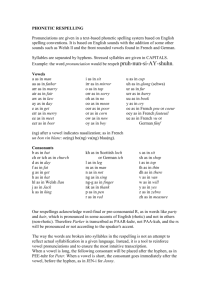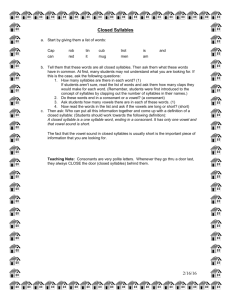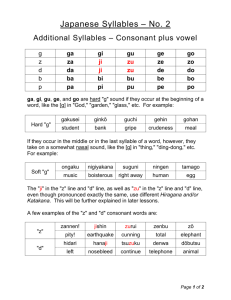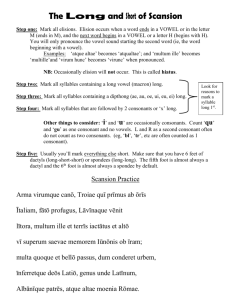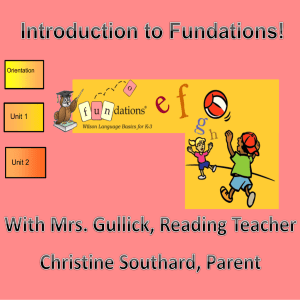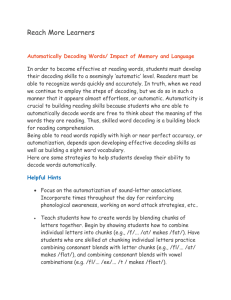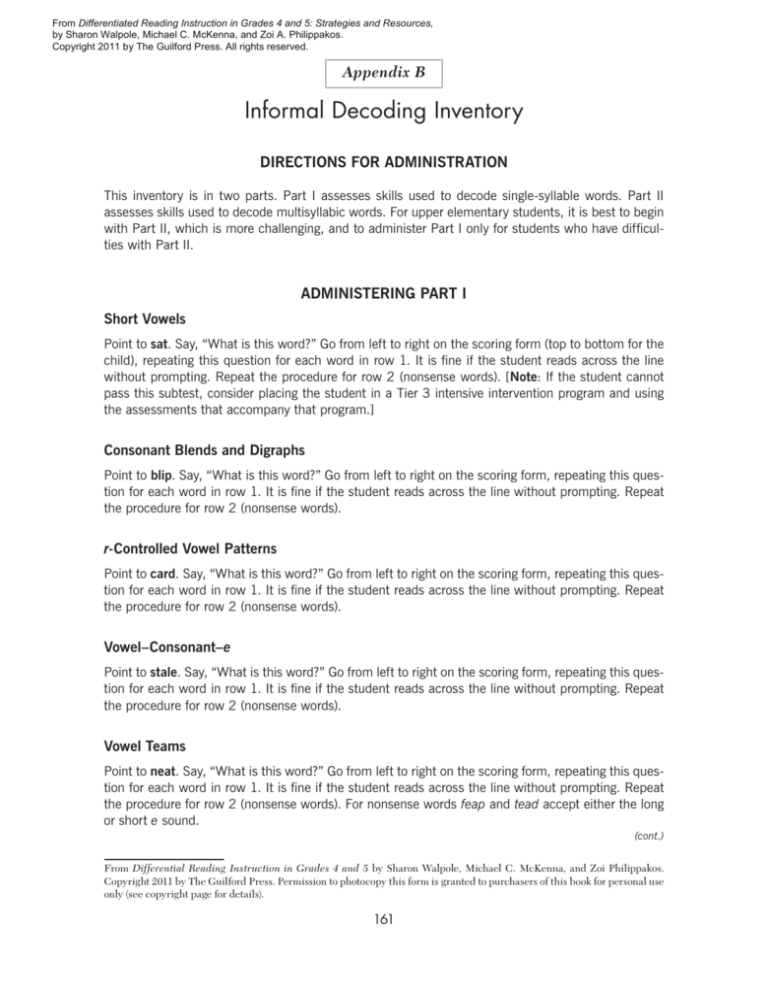
From Differentiated Reading Instruction in Grades 4 and 5: Strategies and Resources,
by Sharon Walpole, Michael C. McKenna, and Zoi A. Philippakos.
Copyright 2011 by The Guilford Press. All rights reserved.
Appendix B
Informal Decoding Inventory
Directions for Administration
This inventory is in two parts. Part I assesses skills used to decode single-syllable words. Part II
assesses skills used to decode multisyllabic words. For upper elementary students, it is best to begin
with Part II, which is more challenging, and to administer Part I only for students who have difficulties with Part II.
Administering Part I
Short Vowels
Point to sat. Say, “What is this word?” Go from left to right on the scoring form (top to bottom for the
child), repeating this question for each word in row 1. It is fine if the student reads across the line
without prompting. Repeat the procedure for row 2 (nonsense words). [Note: If the student cannot
pass this subtest, consider placing the student in a Tier 3 intensive intervention program and using
the assessments that accompany that program.]
Consonant Blends and Digraphs
Point to blip. Say, “What is this word?” Go from left to right on the scoring form, repeating this question for each word in row 1. It is fine if the student reads across the line without prompting. Repeat
the procedure for row 2 (nonsense words).
r-Controlled Vowel Patterns
Point to card. Say, “What is this word?” Go from left to right on the scoring form, repeating this question for each word in row 1. It is fine if the student reads across the line without prompting. Repeat
the procedure for row 2 (nonsense words).
Vowel–Consonant–e
Point to stale. Say, “What is this word?” Go from left to right on the scoring form, repeating this question for each word in row 1. It is fine if the student reads across the line without prompting. Repeat
the procedure for row 2 (nonsense words).
Vowel Teams
Point to neat. Say, “What is this word?” Go from left to right on the scoring form, repeating this question for each word in row 1. It is fine if the student reads across the line without prompting. Repeat
the procedure for row 2 (nonsense words). For nonsense words feap and tead accept either the long
or short e sound.
(cont.)
From Differential Reading Instruction in Grades 4 and 5 by Sharon Walpole, Michael C. McKenna, and Zoi Philippakos.
Copyright 2011 by The Guilford Press. Permission to photocopy this form is granted to purchasers of this book for personal use
only (see copyright page for details).
161
Informal Decoding Inventory (page 2 of 4)
Scoring Part I
Each subtest contains 10 real words and 10 nonsense words. Because real words might be identified at sight, a higher criterion (80%) is used for mastery. For nonsense words, the criterion is 60%.
The criteria for Review and Needs Systematic Instruction differ accordingly. The following table below
gives the number of correct answers that correspond to these percentages. (Note that the total percentages in the bottom row do not always equal the total of the numbers above. They were computed
on a slightly different basis.)
Real Words
Nonsense Words
Mastery
Review
Systematic
Instruction
Mastery
Review
Systematic
Instruction
Short Vowels
8–10
6–7
0–5
6–10
4–5
0–3
Consonant Blends
and Digraphs
8–10
6–7
0–5
6–10
4–5
0–3
r-Controlled Vowel
Patterns
8–10
6–7
0–5
6–10
4–5
0–3
Vowel–Consonant–e
8–10
6–7
0–5
6–10
4–5
0–3
Vowel Teams
8–10
6–7
0–5
6–10
4–5
0–3
40–50
30–39
0–29
30–50
20–29
0–19
Subtest
Total
Administering Part II
Compound Words
Point to batman. Say, “What is this word?” Go from left to right on the scoring form, repeating this
question for each word in row 1. It is fine if the student reads across the line without prompting.
Repeat the procedure for row 2 (coined and nonsense words).
Closed Syllables
Point to dentist. Say, “What is this word?” Go from left to right on the scoring form, repeating this
question for each word in row 1. It is fine if the student reads across the line without prompting.
Repeat the procedure for row 2 (nonsense words).
Open Syllables
Point to lotus. Say, “What is this word?” Go from left to right on the scoring form, repeating this question for each word in row 1. It is fine if the student reads across the line without prompting. Repeat
the procedure for row 2 (nonsense words).
(cont.)
162
Informal Decoding Inventory (page 3 of 4)
Vowel–Consonant–e Syllables
Point to confine. Say, “What is this word?” Go from left to right on the scoring form, repeating this
question for each word in row 1. It is fine if the student reads across the line without prompting.
Repeat the procedure for row 2 (nonsense words).
r-Controlled Syllables
Point to fiber. Say, “What is this word?” Go from left to right on the scoring form, repeating this question for each word in row 1. It is fine if the student reads across the line without prompting. Repeat
the procedure for row 2 (nonsense words).
Vowel Team Syllables
Point to chowder. Say, “What is this word?” Go from left to right on the scoring form, repeating this
question for each word in row 1. It is fine if the student reads across the line without prompting.
Repeat the procedure for row 2 (nonsense words).
Consonant–le Syllables
Point to bubble. Say, “What is this word?” Go from left to right on the scoring form, repeating this
question for each word in row 1. It is fine if the student reads across the line without prompting.
Repeat the procedure for row 2 (nonsense words).
Scoring Part II
As in Part I, each subtest contains 10 real words and 10 nonsense words. Likewise, because real
words might be identified at sight, a higher criterion (80%) is used for mastery. For nonsense words,
the criterion is 60%. The criteria for Needs Improvement and Needs Systematic Instruction differ
accordingly. The following table gives the number of correct answers that correspond to these percentages.
Real Words
Nonsense Words
Mastery
Review
Systematic
Instruction
Mastery
Review
Systematic
Instruction
Compound Words
8–10
6–7
0–5
6–10
4–5
0–3
Closed Syllables
8–10
6–7
0–5
6–10
4–5
0–3
Open Syllables
8–10
6–7
0–5
6–10
4–5
0–3
Vowel–Consonant–e
Syllables
8–10
6–7
0–5
6–10
4–5
0–3
r-Controlled Syllables
8–10
6–7
0–5
6–10
4–5
0–3
Vowel Team Syllables
8–10
6–7
0–5
6–10
4–5
0–3
Consonant–le Syllables
8–10
6–7
0–5
6–10
4–5
0–3
56–70
42–55
0–41
42–50
28–41
0–27
Subtest
Total
(cont.)
163
Informal Decoding Inventory (page 4 of 4)
Readministering the Inventory
The purpose of this inventory is to identify the most promising focus for targeted instruction. Following
such instruction, usually over the course of several weeks, readminister just that portion of the inventory that has been the focus of instruction. It is not necessary to give the entire inventory again. If the
instruction has brought a student to mastery, proceed to the next area where the inventory revealed a
problem. Charting records for students over time will provide an indication of long-term progress and
a tool for judging their response to instruction.
(cont.)
164
Informal Decoding Inventory
Name Date Part I: Single-Syllable Decoding Score Sheet
Short Vowels
sat
pot
beg
nip
cub
pad
top
hit
met
nut
hud
gop
grab
rest
slub
shad
firm
mirth
mork
tarst
Total
mot
tib
han
teg
fet
lup
nid
pab
Total
Consonant Blends and Digraphs
blip
check
clam
chin
thick
frank
mint
fist
Total
clop
prib
hest
chot
slen
bund
bist
hald
Total
r-Controlled Vowel Patterns
card
stork
term
burst
turf
fern
dirt
nark
Total
fird
barp
forn
serp
surt
perd
kurn
nirt
Total
(cont.)
From Differential Reading Instruction in Grades 4 and 5 by Sharon Walpole, Michael C. McKenna, and Zoi Philippakos.
Copyright 2011 by The Guilford Press. Permission to photocopy this form is granted to purchasers of this book for personal use
only (see copyright page for details).
165
Informal Decoding Inventory, Part I (page 2 of 2)
Vowel–Consonant–e
stale
hike
dome
cube
blame
chive
cute
prone
vane
brine
vike
pene
beast
boast
Total
bame
neme
hile
pome
rute
nube
vope
clate
Total
Vowel Teams
neat
spoil
goat
pail
field
fruit
claim
meet
Total
craid
houn
rowb
noy
feap
nuit
maist
ploat
tead
steen
Total
(cont.)
166
167
pladchet
sindict
suncrip
compact
paintrag
carpool
bunpect
hundred
oatfarm
flashlight
skywatch
corndog
wunnet
flannel
blensim
banquet
Closed Syllables
raincan
baseball
Compound Words
pefdimp
submit
dogrun
crosswalk
Part II: Multisyllabic Decoding Score Sheet
Date stindam
contest
meatman
battlefield
Total
flanpeck
Total
blanket
Total
bluestar
Total
frostbite
(cont.)
winsprick
gossip
hattree
bootstrap
From Differential Reading Instruction in Grades 4 and 5 by Sharon Walpole, Michael C. McKenna, and Zoi Philippakos. Copyright 2011 by The Guilford Press. Permission to photocopy this
form is granted to purchasers of this book for personal use only (see copyright page for details).
tunnel
sundog
catboy
dentist
blackmail
batman
Name Informal Decoding Inventory
168
super
sirper
fiber
borniss
athlete
confine
repale
cluden
rulab
depide
lunar
lotus
winler
furnish
wranblise
conclude
diler
cupid
wupper
serpent
mondrine
concrete
slony
spiky
fodun
final
lompise
stampede
sonnor
varnish
darber
jogger
r-Controlled Syllables
slindome
compose
Vowel–Consonant–e Syllables
nicot
pony
Open Syllables
burclust
surplus
sisdike
suppose
siny
spiny
Informal Decoding Inventory, Part II (page 2 of 3)
perstat
servant
dimcline
endure
pady
ivy
Total
birvick
Total
clergy
Total
plinsipe
Total
cascade
Total
pilem
Total
rely
biver
(cont.)
diner
indube
recline
byliss
equal
169
dandle
bubble
scanfle
shoopoy
grinlow
buble
ointment
chowder
fangle
cattle
spoinap
approach
baddle
struggle
haynick
mushroom
slighnat
meadow
magle
bugle
dafle
people
Consonant–le Syllables
reemin
pillow
Vowel Team Syllables
cogle
eagle
crainem
bounty
Informal Decoding Inventory, Part II (page 3 of 3)
pubble
drizzle
moanish
treatment
Total
butle
Total
whistle
Total
flaiwat
Total
maroon
(cont.)
baitle
sprinkle
scoatal
discreet
Single-Syllable Decoding Inventory: Student Materials
sat
pot
beg
nip
cub
pad
top
hit
met
nut
blip
check
clam
chin
thick
frank
mint
fist
grab
rest
card
stork
term
burst
turf
fern
dirt
nark
firm
mirth
stale
hike
dome
cube
blame
chive
cute
prone
vane
brine
neat
spoil
goat
pail
field
fruit
claim
meet
beast
boast
mot
tib
han
teg
fet
lup
nid
pab
hud
gop
clop
prib
hest
chot
slen
bund
bist
hald
slub
shad
fird
barp
forn
serp
surt
perd
kurn
nirt
mork
tarst
bame
neme
hile
pome
rute
nube
vope
clate
vike
pene
craid
houn
rowb
noy
feap
nuit
maist
ploat
tead
steen
(cont.)
From Differential Reading Instruction in Grades 4 and 5 by Sharon Walpole, Michael C. McKenna, and Zoi Philippakos.
Copyright 2011 by The Guilford Press. Permission to photocopy this form is granted to purchasers of this book for personal use
only (see copyright page for details).
170
Multisyllabic Decoding Inventory: Student Materials
batman
blackmail
carpool
flashlight
baseball
corndog
crosswalk
battlefield
frostbite
bootstrap
dentist
tunnel
compact
hundred
flannel
banquet
submit
contest
blanket
gossip
lotus
lunar
cupid
spiky
pony
final
spiny
ivy
rely
equal
confine
athlete
conclude
concrete
compose
stampede
suppose
endure
cascade
recline
catboy
sundog
paintrag
oatfarm
raincan
skywatch
dogrun
meatman
bluestar
hattree
sindict
pladchet
suncrip
bunpect
wunnet
blensim
pefdimp
stindam
flanpeck
winsprick
rulab
cluden
diler
slony
nicot
fodun
siny
pady
pilem
byliss
depide
repale
wranblise
mondrine
slindome
lompise
sisdike
dimcline
plinsipe
indube
(cont.)
From Differential Reading Instruction in Grades 4 and 5 by Sharon Walpole, Michael C. McKenna, and Zoi Philippakos.
Copyright 2011 by The Guilford Press. Permission to photocopy this form is granted to purchasers of this book for personal use
only (see copyright page for details).
171
Multisyllabic Decoding Inventory (page 2 of 2)
fiber
super
furnish
serpent
varnish
jogger
surplus
servant
clergy
diner
chowder
ointment
approach
mushroom
pillow
meadow
bounty
treatment
maroon
discreet
bubble
dandle
cattle
struggle
bugle
people
eagle
drizzle
whistle
sprinkle
borniss
sirper
winler
wupper
sonnor
darber
burclust
perstat
birvick
biver
grinlow
shoopoy
spoinap
haynick
reemin
slighnat
crainem
moanish
flaiwat
scoatal
buble
scanfle
fangle
baddle
magle
dafle
cogle
pubble
butle
baitle
Copyright © 2011 The Guilford Press. All rights reserved under International Copyright
Convention. No part of this text may be reproduced, transmitted, downloaded, or stored in
or introduced into any information storage or retrieval system, in any form or by any
means, whether electronic or mechanical, now known or hereinafter invented, without the
written permission of The Guilford Press.
Purchase this book now: www.guilford.com/p/walpole4
172
Guilford Publications
72 Spring Street
New York, NY 10012
212-431-9800
800-365-7006
www.guilford.com

